
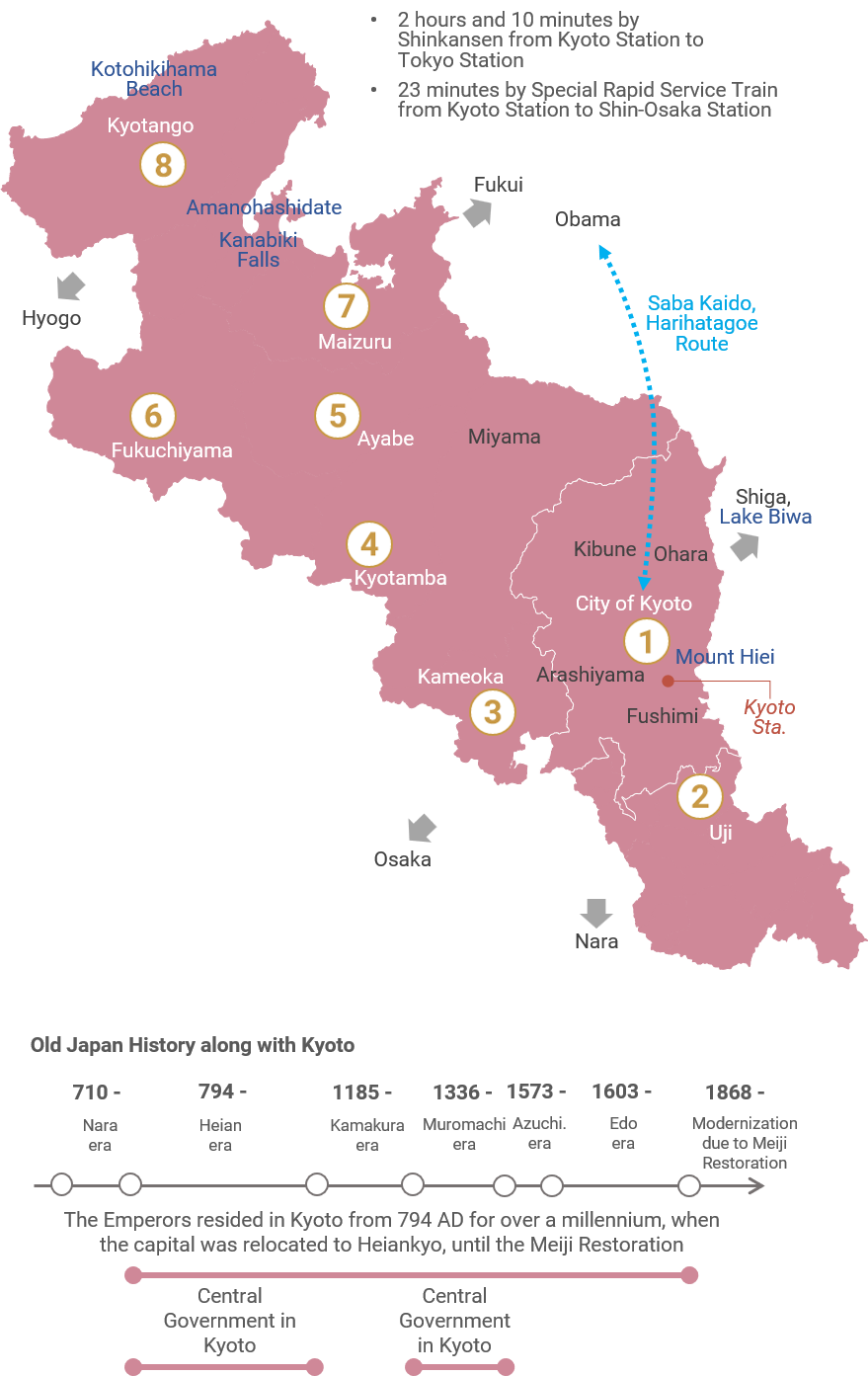
Kyoto, founded as Japan's capital in 794 CE, was home to the imperial family and nobility for about 1080 years, earning the nickname "The Thousand-Year Capital." The culture from the imperial era, including shrines, temples, and traditional customs, is still preserved today
Video by Kyoto City Tourism Association, © Kyoto City Tourism Association.
Uji City has been a key transportation hub and retreat for the imperial family and the Fujiwara clan since the Heian period. Known for its Uji tea, it also features many temples and shrines, including the World Heritage sites Byodo-in Temple and Ujigami Shrine
Video by Uji City Tourist Public Interest Incorporated Association, © Uji City Tourist Public Interest Incorporated Association.
Kameoka is historically significant, with ancient shrines like Atago and Izumo Daijingu. Known for its fertile land since the Nara period, it has thriving agriculture. Shogun Ashikaga Takauji (1305-1358) made it his base during the Kamakura and Muromachi periods
Video by Kameoka City, © Kameoka City.
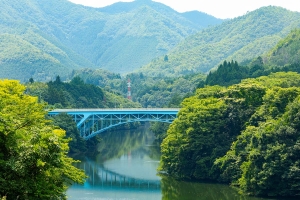
Kyotamba Town, in central Kyoto Prefecture, is known for its lush greenery and clear waters. The Tamba Highlands, a basin with significant temperature differences and clean water, produces special local crops like Tanba chestnuts and black soybeans
Photo by Kyotamba Town Tourism Association, © Kyotamba Town Tourism Association.
Ayabe City in central-northern Kyoto Prefecture offers a picturesque blend of rural and urban life, boasting rich history, culture. It's a vital transportation hub connecting Keihanshin with the Japan Sea region and is renowned for its scenic Ayabe Trail
Video by Ayabe City Tourism Association, © Ayabe City Tourism Association.
Fukuchiyama City, 60 km from City of Kyoto and bordering Hyogo Prefecture, flourished around Fukuchiyama Castle, built by Akechi Mitsuhide (1528-1582). Since the Meiji era, it has become a key transportation hub and a prominent industrial city in Kyoto
Video by Fukuchiyama City, © Fukuchiyama City.
Maizuru City, with its jagged coastline and surrounding mountains, was a key maritime hub in the Edo and Meiji periods, connecting Hokkaido and Tohoku with Osaka. Today, it still hosts Japan Maritime Self-Defense Force facilities
Video by Maizuru Tourism Association, © Maizuru Tourism Association.
Kyotango City, at Kyoto Prefecture's northern tip, is part of the UNESCO San'in Kaigan Geopark, renowned for its scenic coastline. With 15 beaches, it's ideal for driving or cycling around the Tango Peninsula. It's also famous for its crabs and Tango chirimen (silk crepe)
Video by Kyotango City, © Kyotango City.
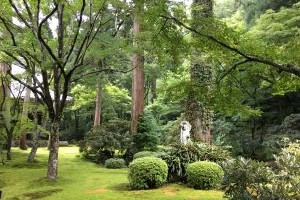
Sanzen-in, with a legacy of imperial family members as head priests, moved to Ohara post the Meiji Restoration. Its name derives from Tendai Buddhist teaching "ichinen sanzen," symbolizing the world's entirety within a single thought. Renowned for its serene atmosphere and moss-covered gardens
View on Google Maps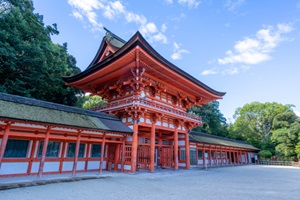
Shimogamo Shrine, believed to have originated around 90 BCE or even before, was worshipped by the Kamo clan for abundant harvests. Its formal name is Kamo Mioya, but it's known as "Shimo"gamo due to its location "downstream" of the Kamo River. Every 21 years, Shikinen Sengu ritual renews its buildings and sacred items
View on Google Maps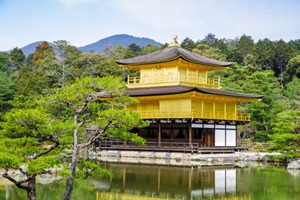
Once a retreat for shogun (military dictator in fuderal Japan) Ashikaga Yoshimitsu (1358-1408) transformed Rokuon-ji into a place of Zen contemplation. Its golden exterior symbolizes purity amidst worldly temptations
View on Google Maps
Originally a villa for shogun Ashikaga Yoshimasa (1436-1490), Jisho-ji later became a Zen temple. Despite lacking its planned silver adornments, its elegance and gardens offer a serene escape
View on Google MapsKyoto State Guest House, symbolizing Japan's history and culture, was built in 2005 to warmly welcome overseas guests and promote friendship. It harmonizes with Kyoto's historic landscape and natural surroundings, featuring traditional Japanese architecture and skilled craftsmanship
Video by State Guest Houses of Japan, © State Guest Houses of Japan.
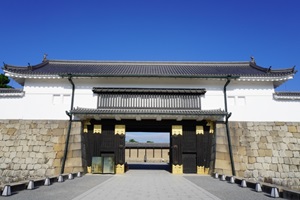
Served as the residence of Japan's shoguns, symbolizing their authority. In 1867, it witnessed the historic moment when the last shogun returned authority to the Emperor, marking the end of the Edo period. Renowned for its elegant architecture, serene gardens, and unique "nightingale floors"
View on Google Maps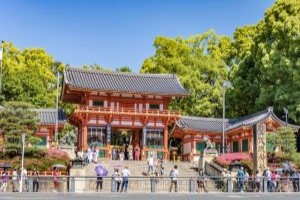
Yasaka Shrine stands at the eastern end of Shijo Street, Kyoto's main street, guarding the city's eastern history. It hosts the famous Gion Festival, one of Japan's three major festivals, originating in the Heian period with prayers for the end of epidemics
View on Google Maps
Perched on the eastern hills of Kyoto, Kiyomizu-dera has stood as a beacon of Buddhist spirituality since its founding in 778 CE. Renowned for its majestic wooden stage, constructed without the use of nails, the temple offers panoramic views of Kyoto's cherry blossoms in spring and fiery foliage in autumn
View on Google Maps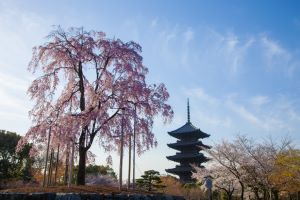
To-ji, the sole remnant of Heian era, was initially built as the official temple for protecting the capital. Later, Emperor Saga gifted it to monk Kukai (Kobo Daishi), and it thrived as a center of Shingon Esoteric Buddhism, holding many cultural treasures. Known for its five-story pagoda, standing as the tallest wooden tower in Japan
View on Google MapsConverted into a temple in 876 CE from Emperor Saga's palace, Daikakuji housed successive emperors and imperial family members as abbots. Notable for its Shinden, used by Shogun Tokugawa Hidetada's daughter. Features "Peony" and "Red Plum" paintings by Kano Sanraku
Video by Daikakuji Temple, © Daikakuji Temple.
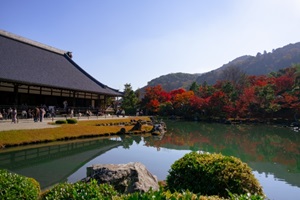
Founded in 1339 by shogun Ashikaga Takauji (1305-1358), Tenryu-ji Temple in Arashiyama features one of Japan's oldest Zen temple gardens. Adjacent to the temple lies an enchanting bamboo grove, adding to the area's allure
View on Google Maps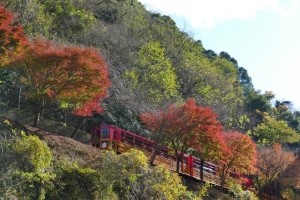
Tourist train along the old San'in Main Line offers year-round scenic views of the beautiful Hozugawa River Valley. 25-minute tour from Saga Station to Kameoka Station, offering the changing scenery throughout the seasons
View on Google Maps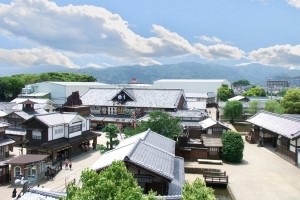
Toei Kyoto Studio Park stands as a pioneer among Japanese theme parks, offering visitors a unique experience. Set within a village reconstructed to resemble an Edo period town, the park allows guests to observe live TV and movie filming
Photo by Toei Kyoto Studio Co.,Ltd, © Toei Kyoto Studio Co.,Ltd.
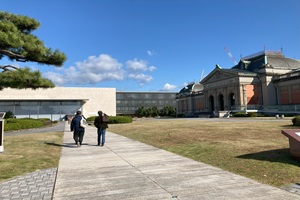
Established in 1897, the Kyoto National Museum specializes in preserving and exhibiting cultural treasures from Kyoto's Heian to Edo periods. It houses around 14,600 items, including art and artifacts from Japan and East Asia
View on Google Maps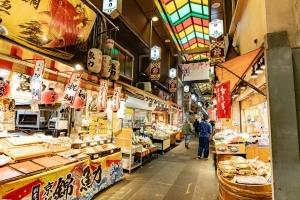
Nishiki Market, located one block north of Shijo Street, is a 390-meter-long shopping street known as the "Kitchen of Kyoto." Dating back to 1615, it features approximately 126 shops lining both sides of the narrow street, offering a wide variety of beloved food by locals
View on Google Maps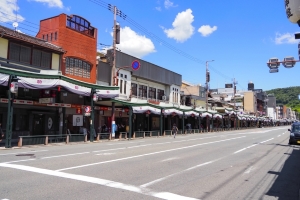
Shijo Street, created when the capital moved to Heian in 794 CE, saw the start of the Gion Festival in 869 CE and thrived with shops by the mid-Heian period. Today, it is a bustling commercial district in downtown Kyoto, lined with department stores, boutiques, and restaurants
View on Google Maps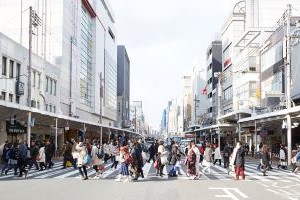
In 1926, the Kawaramachi Streetcar Line opened, improving transportation and turning the area into Kyoto's busiest shopping district. In 1961, the Gion Festival's float procession route was changed to Kawaramachi Street, further enhancing its vibrancy
Photo by Kawaramachi Shopping Street, © Kawaramachi Shopping Street.

Minami-za, Japan's oldest theater, is the only one preserving the tradition of Kyoto's licensed theaters from the early 17th century. The current building, constructed in 1929, is renowned for its beautiful exterior and Art Deco interior
View on Google Maps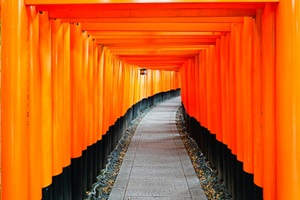
Established in 711 CE, Fushimi Inari Taisha Shrine is renowned for its thousands of vermilion torii gates winding through forest paths on Mount Inari. These gates, donated over centuries, symbolize prayers for success and prosperity. Additionally, Fushimi district is historically known as the sake brewery district of Kyoto, attributed to its abundant clean water sources from the Uji and Katsura rivers
View on Google Maps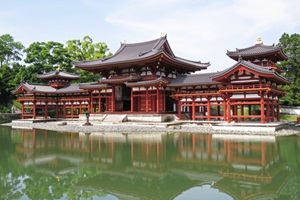
Boasts the iconic Phoenix Hall, a national treasure of Japan depicted on the 10 yen coin. Built in 1053 during the Heian period, it stands as a masterpiece of Buddhist architecture, symbolizing Japan's rich cultural legacy
View on Google MapsProvides a scenic and convenient way to explore the city's cultural heritage and landscapes. With flat terrain and well-maintained paths, visitors can rent bikes and pedal past historic temples, traditional neighborhoods, and serene rivers
Video by City of Kyoto, © City of Kyoto.
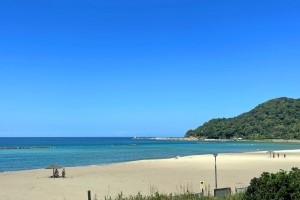
Famous for its unique "singing sand" and breathtaking coastal scenery. Situated along the Sea of Japan, it features clear blue waters, soft sandy shores, and rugged cliffs.The beach is also close to scenic spots like Amanohashidate
View on Google Maps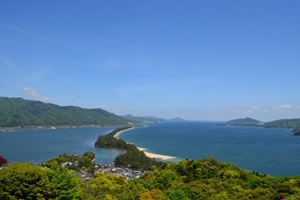
Recognized as a Special Place of Scenic Beauty, is one of Japan's Three Views, along with Matsushima in Miyagi Prefecture and Miyajima in Hiroshima Prefecture
View on Google Maps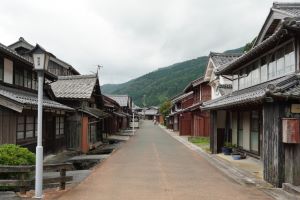
The Saba Kaido, or "Mackerel Road," is an ancient network of roads in Japan that historically linked Wakasa Bay in Fukui Prefecture with Kyoto. Among its routes, the Harihatagoe Route stands out, preserving segments in their original state. Today, it remains a popular destination for hikers
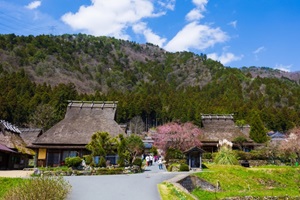
Charming rural area in northern Kyoto Prefecture, known for its picturesque thatched-roof houses and beautiful scenery. Recognized for its cultural and natural significance, it was selected as one of the UNWTO Best Tourism Villages
View on Google MapsThe Aoi Matsuri is an annual festival of the Kamo Shrines, held in Kyoto on May 15th. It features a grand procession spanning approximately 8 kilometers, with participants dressed in Heian-period costumes, celebrating the city's cultural heritage
Video by Kyoto City Tourism Association, © Kyoto City Tourism Association.
Japanese festivals feature rituals called "Kami-mukae" and "Kami-okuri" to welcome and bid farewell to gods' spirits. The portable shrine procession from shrine to resting place is "Shinkōsai," returning as "Kankōsai." Gion Festival mirrors this, with Shinkōsai on July 17th and Kankōsai on July 24th. Preceding these are float processions, "Yamahoko Junko." In 2009, the Gion Festival was recognized as a UNESCO Intangible Cultural Heritage
Video by Kyoto City Tourism Association, © Kyoto City Tourism Association.
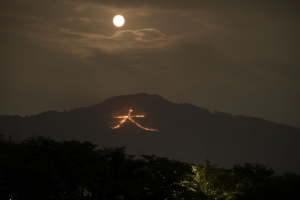
Event held on August 16th as part of the Obon festival in City of Kyoto, where giant bonfires are lit on the mountainsides surrounding the city, forming the shape of a kanji character "大" (meaning "big") to guide the spirits of the deceased back to the afterlife
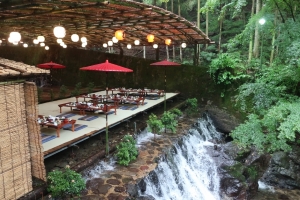
Unique dining experience in Kyoto and Kibune during the hot summer months, where restaurants set up platforms (kawadoko) along the banks of the Kamo River and the Kibune River in Kibune, allowing patrons to enjoy traditional Japanese cuisine in a cool and scenic outdoor setting
The Jidai Matsuri Festival in City of Kyoto, alongside the Aoi Matsuri and Gion Matsuri, celebrates Kyoto's founding and Emperor Kanmu's capital move. Organized by Heian Jingu Shrine, it features a grand procession on October 22, displaying historical costumes. Preceding rituals include prayers, flower offerings, and spirit transfers
Video by Kyoto City Tourism Association, © Kyoto City Tourism Association.
Kyoto cuisine, or "Kyō ryōri," emphasizes seasonal ingredients, refined presentation, and delicate flavors. It's characterized by elegant multi-course kaiseki meals, showcasing traditional dishes such as Kyoto vegetables, tofu, fish and Kyoto-style sushi. With its roots in the tea ceremony, Kyoto cuisine embodies mindfulness, harmony, sophisticated cooking techniques, and a message of respect for nature's bounty and the cultural heritage of Kyoto
Video by Kyoto Tourism Federation, © Kyoto Tourism Federation.
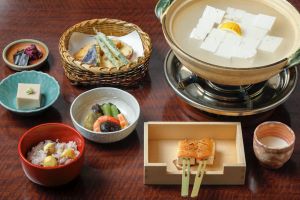
Junsei s renowned for its specialty, yudofu, delicately simmered tofu. With its serene ambiance and commitment to preserving Kyoto's culinary legacy, Junsei offers an unforgettable dining experience
Photo by Junsei, © Junsei.
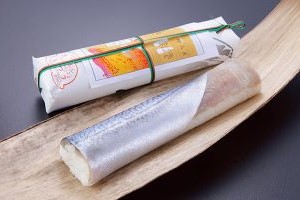
Featuring vinegar-marinated mackerel atop seasoned rice, artfully shaped to resemble a swimming fish. Founded in 1781, Izuu is celebrated for its preservation of traditional sushi-making techniques and flavors
Photo by Izuu, © Izuu.
While many countries preserve diverse regional cuisines, Japan also offers its unique culinary journey. This video highlights select dishes, showcasing distinct local specialties and historical influences in the region
Video by Ministry of Agriculture, Forestry and Fisheries, © Ministry of Agriculture, Forestry and Fisheries.

JR West issues the ICOCA card, a rechargeable smart card for transportation and shopping, akin to Suica. It facilitates easy fare payment on trains, buses, and at stores nationwide. However, it's region-specific and cannot be used for inter-JR region travel, except for special Shinkansen deals via Express Reservations

JR WEST offers various ticket deals and passes catering to different travel needs in western Japan. Find your best from the above link
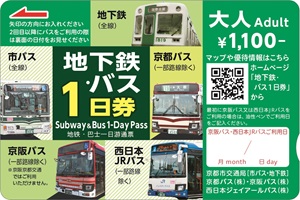
The Kyoto Subway, Bus One-Day Pass offers unlimited travel on the city's subway lines and buses for a day. It's convenient and affordable, sold at major stations and terminals
Kintetsu Railway, operating in Osaka, Nara, Kyoto, Mie, and Aichi Prefectures, is one of Japan's major private railways. With a network spanning 501.1 km, it boasts the longest line among Japan's private rail operators, excluding the JR Group
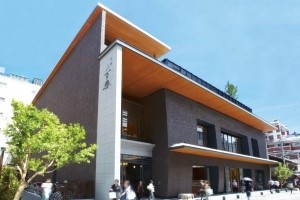
At Yaoichi, you'll find a wide selection of Kyoto's unique ingredients. Their deli offers both traditional Kyoto dishes and exclusive creations. Their bento assortment, offering boxed meals, is diverse and fulfilling
Photo by Kyoto Yaoichi Honkan, © Kyoto Yaoichi Honkan.
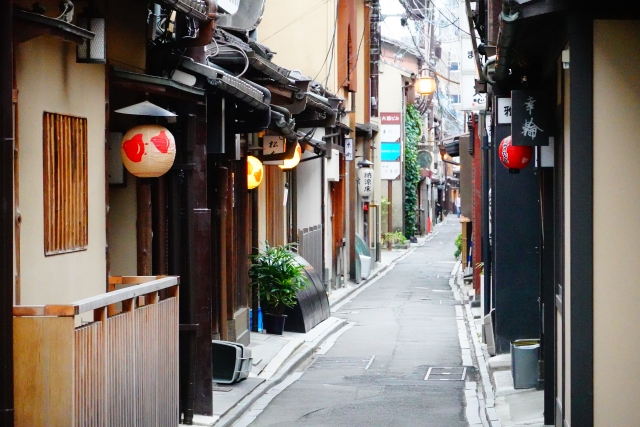
Pontocho, a historic alley in the city center, is famed for its traditional tea houses, restaurants, and bars. Its enchanting cobblestone streets and lantern-lit ambiance offer a glimpse into the elegance of old Kyoto, while the alley buzzes with activity throughout the night
View on Google MapsSpans 10.7km, connecting Kyoto's iconic Arashiyama with the serene Takao. Offering breathtaking views of the Nishiyama mountain range, Hozugawa Gorge, and Kyoto cityscape, it's not only a scenic drive but also a beloved leisure destination for locals
Video by Nishiyama Driveway Co., Ltd, © Nishiyama Driveway Co., Ltd.
Kyoto Prefecture, located in Japan’s Kinki region, is renowned for its cultural heritage, historic sites, and natural beauty. Its capital is the City of Kyoto, which served as Japan’s imperial seat from 794 CE until the Meiji Restoration in 1868 and remains a symbol of traditional culture. The city attracts millions annually with its UNESCO World Heritage sites, seasonal festivals, and refined craftsmanship. Zen philosophy, central to Kyoto’s cultural identity, emphasizes meditation and harmony—values deeply reflected in its temples, gardens, and way of life.
Video by Kyoto Tourism Federation, © Kyoto Tourism Federation.